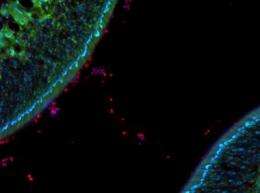Gatekeepers: Study discovers how microbes make it past tight spaces between cells

There are ten microbial cells for every one human cell in the body, and microbiology dogma holds that there is a tight barrier protecting the inside of the body from outside invaders, in this case bacteria. Bacterial pathogens can break this barrier to cause infection and senior author Jeffrey Weiser, MD, professor of Microbiology and Pediatrics from the Perelman School of Medicine at the University of Pennsylvania, and first author Thomas Clarke, PhD, a postdoctoral fellow in the Weiser lab, wondered how microbes get inside the host and circulate in the first place. Weiser and Clarke tested to see if microbes somehow weaken host cell defenses to enter tissues.
In this Cell Host & Microbe study, the investigators found that microbes open and get through the initial cellular barrier -- epithelial cells that line the airway -- in a programmed and efficient way. They surmise this could be a normal physiological event and the epithelial lining may not be as effective at keeping microbes out as once thought. Microbes that survive once past the epithelial lining tend to be pathogenic, such as Streptococcus pneumoniae and Haemophilus influenzae, two major human pathogens causing invasive infections. Their data support a general mechanism for epithelial opening exploited by invasive pathogens to facilitate movement into tissue to initiate disease.
Using microarray and PCR analysis of the epithelial cells' response to invasion by S. pneumoniae and H. influenzae, the researchers found a downregulation of genes called claudins that encode proteins key to keeping the spaces between epithelial cells tight. All animals recognize molecules in microbial cell walls. It was detection of these microbial molecules by host molecules called Toll-like receptors that caused the proteins responsible for keeping the cellular barrier tight to fall down on the job.
When modeled in a cell assay, claudin downregulation was preceded by upregulation of another protein called SNAIL1 that suppresses claudins, the cellular components that keep the junctions tight. What's more, inhibiting claudin expression in a cell assay or stimulating the Toll-like receptors in an animal model loosened the junctions between cells and promoted bacterial movement across the epithelium.
"This study provides an understanding of how microbes gain access into their host to affect its physiology," concludes Weiser.
Provided by University of Pennsylvania School of Medicine














